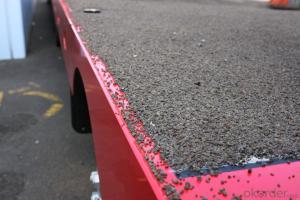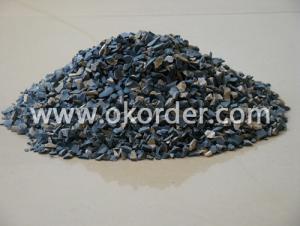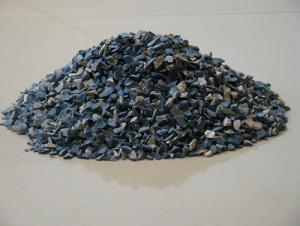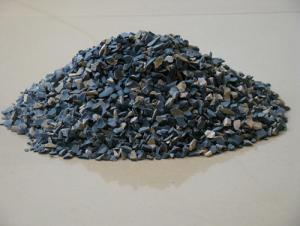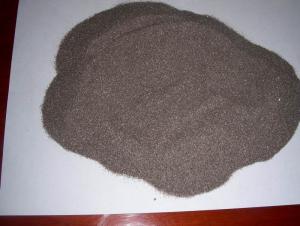calcined bauxite for refractory bricks
- Loading Port:
- China main port
- Payment Terms:
- TT OR LC
- Min Order Qty:
- 25 m.t.
- Supply Capability:
- 10000 m.t./month
OKorder Service Pledge
OKorder Financial Service
You Might Also Like
Quick Details
| Place of Origin: | Shanghai, China (Mainland) | Shape: | Brick | Material: | Alumina Block |
| SiO2 Content (%): | 3~9% | Al2O3 Content (%): | 3~25% | MgO Content (%): | 40~60% |
| CaO Content (%): | 2% | Refractoriness (Degree): | 1770°< Refractoriness< 2000° | CrO Content (%): | 8~20% |
| SiC Content (%): | none | Model Number: | KS1323 | Brand Name: | cnbm |
Packaging & Delivery
| Packaging Details: | carton |
| Delivery Detail: | 3~5days |
Specifications
calcined bauxite for refractory bricks
Refractory Bricks magnesia chrome bricks are mainly made from sintered
calcined bauxite for refractory bricks
Specifications
Refractory Bricks magnesia chrome bricks are mainly made from sintered magnesia and chrome-oxide after high pressure shaped
Refractory Bricks magnesia chrome bricks are mainly made from sintered magnesia and chrome-oxide, by high pressure shaping and high temperature firing. According to different requirements, the contents of the Cr2O3 can be changed.
item\index | MGe-8 | MGe-12 | MGe-16 | MGe-20 |
MgO,% ≥ | 60 | 55 | 45 | 40 |
Cr2O3,% ≥ | 8 | 12 | 16 | 20 |
Apparent porosity % ≤ | 21 | 21 | 23 | 23 |
Cold crushing strength,MPa ≥ | 30 | 30 | 30 | 30 |
0.2MPa the load softens the beginning temperatur/°C ≥ | 1530 | 1550 | 1550 | 1550 |
Heat shock resistance(950°C air cooling),each ≥ | Provide the data | |||
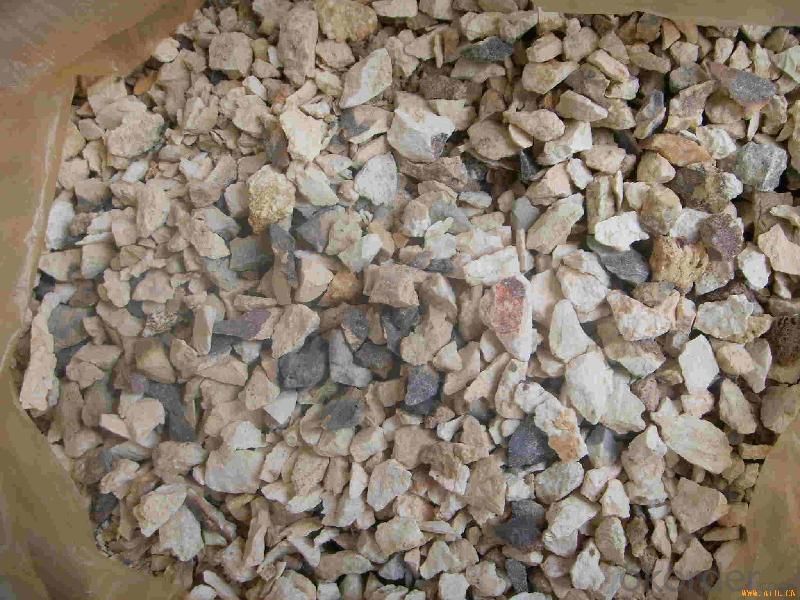
- Q:What is fire retardant coating mainly used for?
- Fire retardant coating is a coating which is applied to the surface of buildings and structures and can form a protective layer of fire retardancy and thermal insulation. It can reduce the flammability of the coated materials and block the rapid spread of fire so as to improve fire endurance of the coated materials. Features of fire retardant coating: (1) Fire retardant coating itself has a flame-retardancy or non-inflammability, and it can prevent the protected substrate from direct contact with the air, and delay ignition and reduce the burning speed of the objects. (2) In addition to flame retardancy or non-inflammability, the fire retardant coating itself has a a low thermal conductivity, which can delay the transfer of flame temperature to the substrate to be protected. (3) When heating, fire retardant coating decomposes non-combustible inert gas to dilute the combustible gas decomposed by the protected, making it difficult to burn or slow down the burning rate. (4) Fire retardant coating containing nitrogen will decomposite NO, NH3 and other basic groups, which compound with the organic radicals and interrupt the chain reaction so as to reduce the temperature. (5) intumescent fire retardant coating will expand and foam when heating, and form a carbon foam insulation to block the protected objects, thus delaying the transmission of heat to the substrate.
- Q:What are the advantages of refractory material?
- Jingute WHL type, GDS type
- Q:Who knows about roof fireproofing materials?
- Roof thermal insulation materials are various which generally can be divided into two categories, namely inorganic and organic materials: Inorganic materials are expanded perlite, aerated concrete, rock wool, glass wool, etc. Organic materials are styrofoam, polyurethane?foaming?plastic and so on. A. common roof thermal insulation materials 1. the expanding polystyrene board (EPS) has good thermal insulation performance, and cheap price but poor intensity with heat conductivity coefficient of 0.038-0.041. 2. extruded polystyrene board (XPS) has better thermal insulation performance and high intensity but an expensive price with heat conductivity coefficient of 0.028-0.03. It is moisture resistant but needs treatments on surface in construction. 3. rock wool board, with heat conductivity coefficient of 0.041-0.045, is fireproofing, fire?retardant. It has a good hygroscopicity performance but is poor in thermal insulation. 4. gelatine powder polyphenyl granule heat insulating slurry, with heat conductivity coefficient of 0.057- 0.06, has a good flame resistance performance, but the results of recycling and thermal insulation are unsatisfactory. It has high construction requirements. 5. polyurethane foaming material, with heat conductivity coefficient of 0.025-0.028, has good waterproofness and thermal insulation performance, as well as high intensity, but it is expensive. 6. perlite and other slurry, with heat conductivity coefficient of 0.07-0.09, have good flameproofness and water-absorbing ability but are poor in thermal insulation and thermostability.
- Q:What is fireproofing material? Are fireproof materials the same thing with thermal insulation materials and refractories?
- Fireproofing material is inorganic board, while thermal insulation material belongs to organic board. Fireproof material can also preserve heat, but it is not as good as thermal insulation material in this aspect.
- Q:Physical and chemical indicators of various refractory.
- it depends on what it is for. There are thousands of kinds of refracroties. You should just ask what you need.
- Q:How to divide the fire rating standards of insulation materials?
- The fire rating classification standards of insulation materials, 1. Insulation materials with A-level combustion performance: inorganic fiber spraying, rock wool, glass wool, foam glass, ceramic foam, foam cement, close-celled perlite, etc. 2. Insulation materials with B1-level combustion performance: specially-treated extruded polystyrene boards(XPS)/ specially-treated Polyurethane(PU), Phenolics, Polystyrene rubber powder particles,etc. 3. Insulation materials with B2-level combustion performance: Expanded polystyrene sheets(EPS), Extruded polystyrene board(XPS), Polyurethane(PU), Polyethylene(PE), etc.
- Q:What's meaning of CN of fire-resistant material?
- The commonly used preparation methodsinclude shock compression, high-pressure pyrolysis, ion implantation, reactive sputtering, plasma chemical vapor deposition, electrochemicaldeposition, ion beam sputtering, , low-energy ion radiation, pulsed arc discharge,pulsed laser inducing, etc. But the compounding result of superhard materialis not ideal due to deposition of amorphous CN film, nanometer level sizedC3N4 crystalline grain set in the amorphous film and few large graincrystal.
- Q:Fire rating of decoration materials
- You can refer to (code for fire protection design of buildings)
- Q:What kind of flexible fireproof material is really good?
- Flexible waterproof materials mostly are asphalt, linoleum and other organic material, which is also called linoleum coiled material waterproof layer. it uses the linoleum, glass cloth fabric as tire layer coil, using all kinds of cementing material phase of asphalt and so on. Make coil bind on roof structure plate leveling layer to form waterproof layer. Flexible waterproof material has high tensile strength, big elongation and light quality, which is convenient to construct. But it has relatively strict operation technology can resistant penetration and aging resistance than rigid materials, aging. Its life is short. Refers to a kind of waterproof material form relative to the rigid waterproofing materials such as waterproof mortar and waterproof concrete. In the form of its and grassroots attached two categories, it includs waterproof coating and waterproofing materials. According to different paste position of waterproof material, it can be divided into outside waterproof waterproof (outsourcing) and inside waterproof (insourcing waterproof) two kinds. Waterproof coil material must be stuck in the grass-roots that have enough stiffness of the. Before pasting, you should apply leveling layer and waterproof layer should be added protective layer of the outside, and need to make the rotation of the flexible material, the processing of subsequent and head closing, in order to ensure the continuity of the waterproof layer and sealing. In addition, there are all kinds of waterproof material and moistureproof coating material.
- Q:How long is the fire-resistant time of fireproof wooden door?
- fire endurance class A (1.5 hours), class B (1.0 hours), class C (0.5 hours).
1. Manufacturer Overview |
|
|---|---|
| Location | |
| Year Established | |
| Annual Output Value | |
| Main Markets | |
| Company Certifications | |
2. Manufacturer Certificates |
|
|---|---|
| a) Certification Name | |
| Range | |
| Reference | |
| Validity Period | |
3. Manufacturer Capability |
|
|---|---|
| a)Trade Capacity | |
| Nearest Port | |
| Export Percentage | |
| No.of Employees in Trade Department | |
| Language Spoken: | |
| b)Factory Information | |
| Factory Size: | |
| No. of Production Lines | |
| Contract Manufacturing | |
| Product Price Range | |
Send your message to us
calcined bauxite for refractory bricks
- Loading Port:
- China main port
- Payment Terms:
- TT OR LC
- Min Order Qty:
- 25 m.t.
- Supply Capability:
- 10000 m.t./month
OKorder Service Pledge
OKorder Financial Service
Similar products
New products
Hot products
Related keywords
